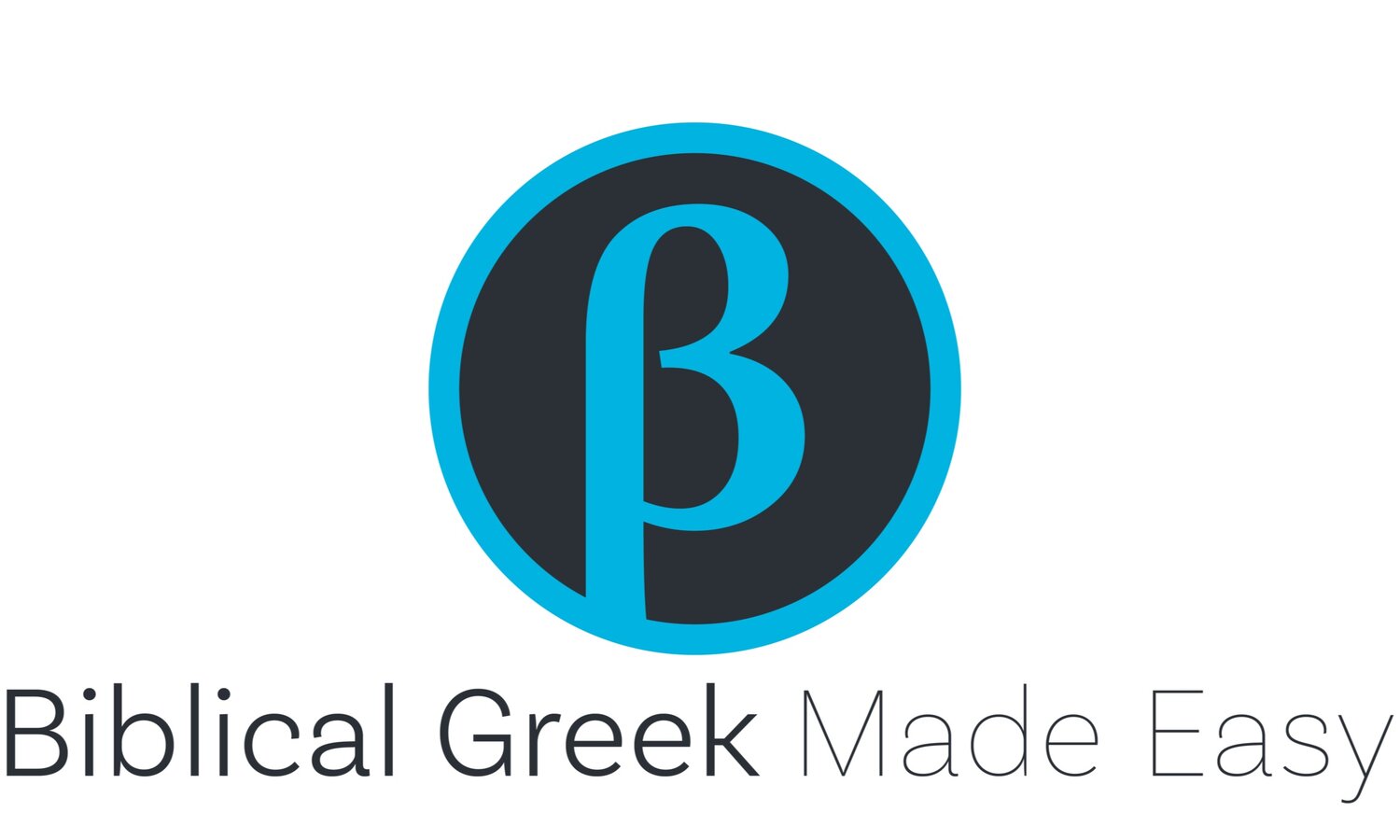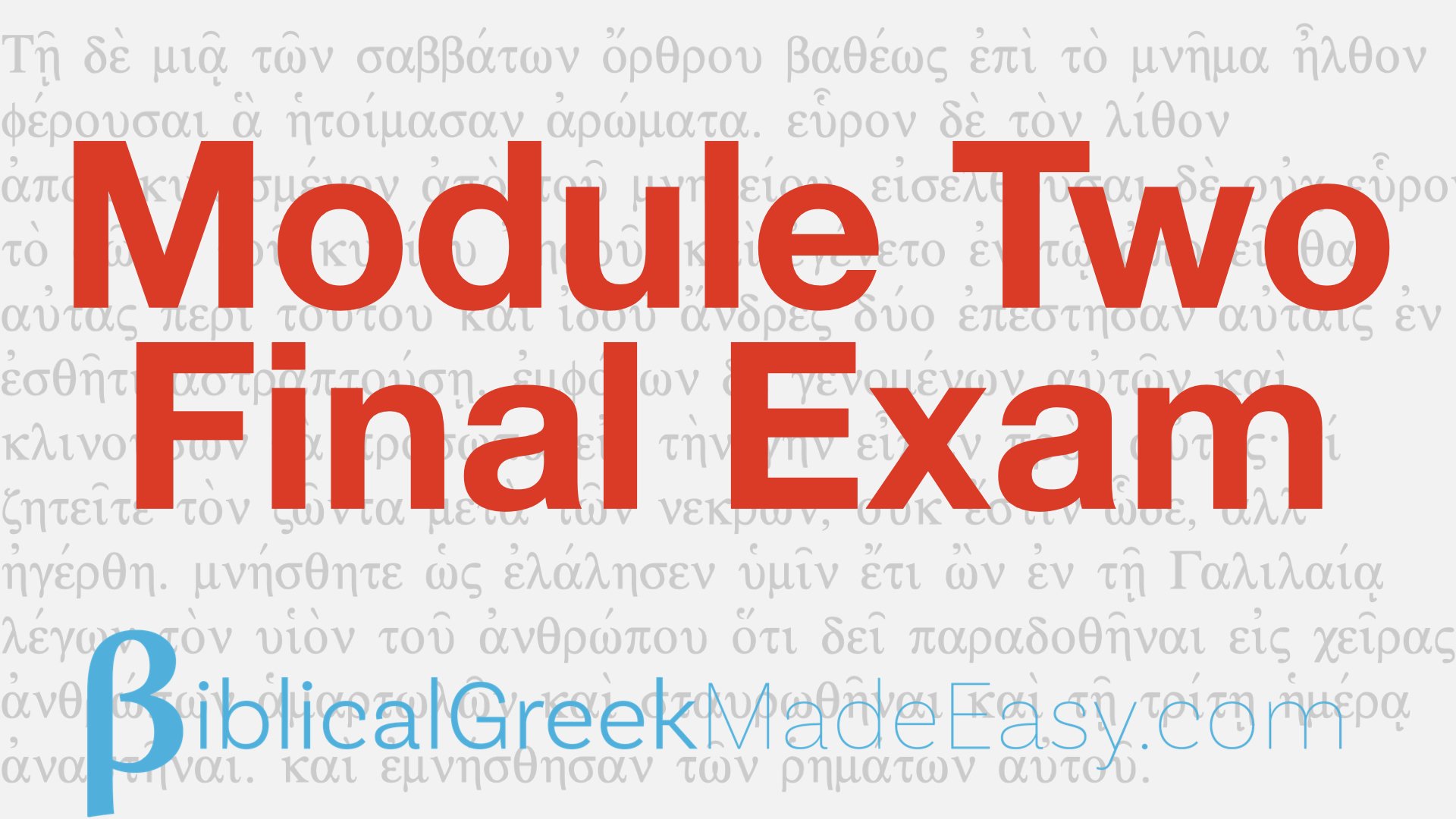Module 2: The Greek Verb
Welcome to module 2, which is all about the Greek verbal system. We teach you everything you need to know about the different Greek verbal tenses and moods, plus other verb-related concepts, like participles, imperatives, and infinitives. As always, we make it fun and easy for you to learn at your own pace, minimizing the memorization and focusing on what is most central to learn the language. Finish the module, take the final exam, and get your certificate!
Class 1: Intro to Verbs & Present Active Indicative
This class contains an introduction to the Greek verbal system as well as our first verbs to learn: the present active indicative.
M2Handout 1.1: Present Active Indicative Verbs
Here is the answer key for the module 2 quizzes. Remember, only use what you need, and don’t look ahead to spoil things for yourself, but this can help you check your work as you go.
Here is the bonus video for this week. where we translate John 1:29-34. Here is the practice sheet to do the translation on your own.
Class 2: Contract Verbs
Some verbs are weird and change vowels when they are formed. Where some Greek teachers are obsessive about students remembering every combination, we eliminate all of that and give you what you need.
M2Handout 2.1: PAI vs Contract Verbs
Here is Quiz 2.
In this bonus video, we translate John 1:35-42. Here is the practice sheet.
Class 3: Present Middle Passive Indicative
In this class we learn our second set of endings as we tackle middle and passive verbs. This is a key step in our exploration of Greek verbs, and we try and have a little fun along the way.
M2Handout 3.1: Present Mid/Pass Indicative
M2Handout 3.2: Master Verb Chart
Translation of John 1:43-51. Here is the practice sheet.
Class 4: The 4 Patterns of Future Active & Middle Indicative
In this class we learn our second tense, the future. We also start to see all of the weirdness that can come into play with Greek verbs as we look at the different patterns of the future. We will break it down for you and make it as easy as possible.
M2Handout 4.1: Future Active/Middle Indicative
M2Handout 4.2: Liquid Future
We start John chapter 2! Here is the practice sheet.
Class 5: Imperfect Indicative
Ahhh, the past tense. It is so wonderfully specific in Greek, and we start that journey today. Imperfect is the first of the past tenses we learn and it is exegetically significant. We show you how to recognize it, translate it, and deal with it. This class also introduces you to the BGME method of verbal recognition. This is a method I developed teaching Greek that has helped countless students deal with the complexity of the verbal system and take it one step at a time.
M2Handout 5.1: Imperfect
M2Handout 5.2: Master Endings Chart
M2Handout 5.3: BGME Method for Verbal Recognition
In the bonus video this week, we translate John 2:12-17. Here is the practice sheet.
Class 6: Second Aorist
We continue in the past tense in this class with the second (or the weird forms of) the aorist. Get ready for some stem changes, because that is what this class is all about. Again, we help you and provide what you need to learn it.
M2Handout 6.1: 2nd Aorist
M2Handout 6.2: 2nd Aorist Forms 50+ in NT
We translate John 2:18-25. Here is the practice sheet.
Class 7: First Aorist
First aorist is the regular form of the aorist. Remember that aorist is the most used verb tense in the New Testament, so we need to know it well.
M2Handout 7.1: First Aorist
We translate John 3:1-13. Here is the practice sheet.
Class 8: Aorist & Future Passive
We delayed learning the passive tenses of the future and the aorist…until now. They are formed very similarly, so that is why we learn them together, Again, we do the heavy lifting for you so you can just focus your brain power on what you need to.
M2Handout 8.1: Aorist and Future Passive
We translate John 3:14-21. Here is the practice sheet.
Class 9: Perfect
The. perfect tense is the final type of past tense we learn, and at this point in your Greek journey it is a breath of fresh air. We teach you all about the perfect tense in this class.
M2Handout 9.1: Perfect Indicative
We translate John 3:22-30. Here is the practice sheet.
Class 10: Participles, Part 1
Ahhh participles, a wonderful part of your Greek journey. Let’s be honest: Greek participles have haunted the nightmares of Greek students for a long time. But we say, NO MORE! It doesn’t have to be that way! We introduce you to participles in a way you can handle, that empowers you to read and translate the New Testament.
M2Handout 10.1: Present and Aorist Participles
M2Handout 10.2: Master Participles Chart
We translate John 3:31-36. Here is the practice sheet.
Class 11: Participles, Part 2
We continue participles in this class. The complexity of participles casn be a lot, but understanding them and how to translate them can be very rewarding.
We translate John 4:1-10. Here is the practice sheet.
Class 12: Subjunctive
There are other moods! We move into the subjunctive in this class period, opening up your translation ability into moods other than the indicative. Subjunctive can be a lot of fun, and it is pretty easy to recognize once you know what you’re looking for.
M2Handout 12.1: Subjunctive
We translate John 4:11-17. Here is the practice sheet.
Class 13: Infinitives
In these last few classes of module 2, we are rounding out some of the key things you need to learn to finish first year biblical Greek. This class is all about infinitives: how they work, how to recognize them, and how to translate them.
M2Handout 13.1: Infinitives
We translate John 4:17-26. Here is the practice sheet.
Class 14: Imperatives
Imperatives, or commands, are important in the New Testament. The epistles, for example, often have a section toward the end of the letter that instructs the recipients on what to do. These places are certainly not the only places that imperatives occur in the New Testament, so we need to learn them. Greek imperatives can do more than English imperatives, so join me as I teach you about this powerful feature of Greek grammar and how to use it.
M2Handout 14.1: Imperatives
We translate John 4:27-38. Here is the practice sheet.
Class 15: -mi Verbs
In this final class of module 2, we learn -mi verbs. This is a pattern of verbs that is unique, not conforming to most of the rules we have already learned for verbs. If you are following along in the Basics of Biblical Greek Textbook, we cover three chapters in this class, giving you all you need to know about -mi verbs in one spot.
M2Handout 15.1: -mi Verbs
We translate John 4:39-50. Here is the practice sheet.
Here is the final exam for module 2 for when you are ready.
This us a long translation that combines much of what you have learned over 2 modules. Don’t be scared, and don’t be concerned if you aren’t perfect on this. But this is a good chance to set some time aside and spend some time translating something at your current level without any helps. Don’t worry, timelines and grading and end of semester grades and all that are not part of this. But I wanted to give you a chance to complete this module with a final exam if you wanted.
Complete Module 2? Get your certificate!
You have worked hard! Be sure to celebrate that with an official Biblical Greek Made Easy certificate of completion for Module 1: Beginning Biblical Greek. Click here.
“"I have fought the good fight, I have finished the race, I have kept the faith." — 2 Timothy 4:7





























